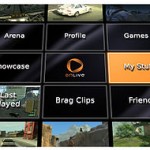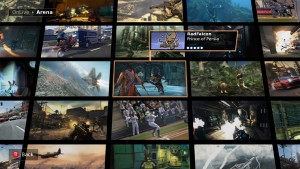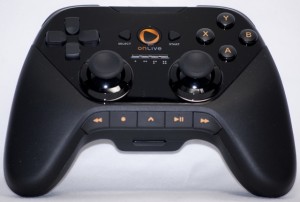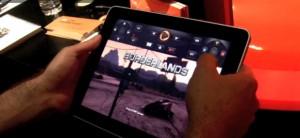 If you showed OnLive to someone five years ago they would be shocked into silence. If you showed it to someone ten years ago they would burn you as a witch. Even today it can elicit an impressed reaction from the most jaded of gamers. I had never tried the service until I got some shiny new hardware to try it on. When I did, I felt a little bit like I was glimpsing the future.
If you showed OnLive to someone five years ago they would be shocked into silence. If you showed it to someone ten years ago they would burn you as a witch. Even today it can elicit an impressed reaction from the most jaded of gamers. I had never tried the service until I got some shiny new hardware to try it on. When I did, I felt a little bit like I was glimpsing the future.
When I managed to get a hold of a tablet I was left with that perennial problem of a new hardware owner in 2012. I had installed Facebook, Twitter, Google+ (so I could talk to my ghost friends) and a comic book viewer. I thought to myself: this is pretty sweet. Now what?
Well as a website owner that tries its hardest to write about games in a mature way, or at least an amusingly immature way, I wanted some games. As anyone who knows the Android store will attest, its a treasure trove of choice. More accurately though, the “trove” is at the bottom of an unending sea of sewage and running your fingers through it, you may pull out a diamond ring but you’re far more likely to uncover something far less…. shall we say: sparkly?
 In particular the Android store pales in comparison to the App store. The App store remains a puzzling but beautiful thing: an environment created by a company ambivalent towards gamers, but that nonetheless has become an incredibly vibrant and fertile breeding ground for great new games. The quality control and sheer variety is not (yet) there on Android devices. What is there is something just as interesting though. The OnLive app.
In particular the Android store pales in comparison to the App store. The App store remains a puzzling but beautiful thing: an environment created by a company ambivalent towards gamers, but that nonetheless has become an incredibly vibrant and fertile breeding ground for great new games. The quality control and sheer variety is not (yet) there on Android devices. What is there is something just as interesting though. The OnLive app.
For those that don’t know, OnLive is a cloud gaming platform. What does this nonsense-sounding term mean? Well the games are not resident on your own hardware. Rather they are run on servers and only the output of the game – in effect streaming footage of the game – is sent to your device which acts as a terminal. From the moment the service was unveiled at GDC in 2009 there was immense scepticism about whether this could even work, whether the frame rates would suffer and whether the games would “feel” like proper games when you were playing. It took a while to get the answer, but the results are in. OnLive works. As long as you have a halfway decent internet connection, it feels as responsive and engaging as if you were running the game on your own machine.
Of course the huge advantage of OnLive is how it opens up games to markets that could not previously play them. From people with ancient laptops to those odd Mac users, all the games on OnLive are playable and they look far better than the hardware of those machines would be able to manage. Again, it depends on your net connection as the quality of the feed degrades as your connection speed slows, but with decent broadband you can play some modern games in their full glory.
 While its impressive on a PC or on a television running from its little cute box, OnLive really feels like a little bit of the future when you run it on a tablet. The success of the iPad paved the way for other hardware manufacturers to enter the market with their own devices, and as Samsung, Motorola, Acer and others produced new tablets that gradually increased in power and build quality, tablet gaming became more important. While the early waves of games on these devices were often ports of simple phone games, its the arrival of the OnLive Service that marks the moment when console quality games come to our flattened friends.
While its impressive on a PC or on a television running from its little cute box, OnLive really feels like a little bit of the future when you run it on a tablet. The success of the iPad paved the way for other hardware manufacturers to enter the market with their own devices, and as Samsung, Motorola, Acer and others produced new tablets that gradually increased in power and build quality, tablet gaming became more important. While the early waves of games on these devices were often ports of simple phone games, its the arrival of the OnLive Service that marks the moment when console quality games come to our flattened friends.
Playing on a Samsung Galaxy 10.1 tab, the first thing I noticed when I started OnLive is the first thing everyone is shocked by: the wall of real-time footage of games. Making up the background wallpaper of the app, this footage of gaming sessions – all of which are captured in real time – is something to behold. Straight away it shows you the strength of the service and the unique way it showcases these game sessions is enough to impress any console gamer.
Moving onto the interface, the whole thing is remarkably easy to use. The first time I tried it was in an area with terribly slow internet and as a result all the menus and options I saw looked like a low resolution video from an ancient mobile phone. Moving to play on a halfway decent connection though the menus and interface look great, and the ease and simplicity of their use should be a lesson to Sony and (especially) Microsoft on how to design a front end. In particular, its easy to filter games that are optimised for a touch screen, mouse and keyboard or gamepad.
You can watch a play session of other gamers in the arena, and this acts as a great way to choose which game looks interesting or worth purchasing. In fact, as a gamer its incredibly satisfying to just sit back and watch someone else play in the arena. The fact that all of this is effectively free is great. Further, when it comes to value OnLive has improved significantly from its initial release. The first half hour or even hour of most games are available for free. This is even better than a demo in my mind, and its great that you get a taster of all the games on the service without spending a penny.
 The OnLive controller is a sturdy and satisfying peripheral. A little smaller than an XBox controller, but with a very similar design, it felt comfortable and expensive in my hands. The triggers and analogue sticks in particular feel better to me than either Sony or Microsoft’s equivalents, and there’s more than enough buttons on the thing to allow all sorts of combinations. It should be noted that not everyone agrees; our site member BigBearScot thought the controller felt a little cheap. As always, other opinions are available.
The OnLive controller is a sturdy and satisfying peripheral. A little smaller than an XBox controller, but with a very similar design, it felt comfortable and expensive in my hands. The triggers and analogue sticks in particular feel better to me than either Sony or Microsoft’s equivalents, and there’s more than enough buttons on the thing to allow all sorts of combinations. It should be noted that not everyone agrees; our site member BigBearScot thought the controller felt a little cheap. As always, other opinions are available.
With the Wii U fast approaching, its interesting to see how the gaming world has come to accept tablets and touch screens. Its sobering to think how primitive the Wii U is though. The primary touch screen controller doesn’t offer multitouch, its essentially a dumb terminal and hence can’t be used without the console or taken away from the home and the console only allows one device. Compare this to gaming on an Android tablet (or an iPad) with OnLive and you have a flexible multi touch device that you can take with you on the go, that can connect with a Bluetooth controller and that can output graphics that the Wii U is technically incapable of producing. This of course isn’t a completely fair comparison – Nintendo will always surprise and innovate on limited technology and OnLive on the go isn’t really feasible on current 3G networks, but nonetheless modern games running on a tablet device feels more like the future than Nintendo’s newest console.
It seems that the creative minds behind OnLive are realising how big a market the tablet could be for them. With dedicated games made for touch screen devices, as well as games remade to suit it better like Dawn of War 2, its clear they recognise this growing market. Additionally, pricing schemes are far more attractive than they were at the services launch with rentals as well as regular special offers now available. With progress in game tracked between all devices that use OnLive, its perfectly possible to rent a game and start playing on the PC, before moving to continue play of the same game session on a tablet in bed.
 Its obvious that the big console makers will be looking at OnLive with interest. Its a scalable service that will become more powerful as internet speeds go up across the country, and it doesn’t require the gamer to buy new hardware to have better looking games. It also takes games away from being a product entirely and makes them a service instead. This is increasingly the business model favoured in the industry and its OnLive that’s paving the way more than Activision with its season passes or Zynga with its micro transactions.
Its obvious that the big console makers will be looking at OnLive with interest. Its a scalable service that will become more powerful as internet speeds go up across the country, and it doesn’t require the gamer to buy new hardware to have better looking games. It also takes games away from being a product entirely and makes them a service instead. This is increasingly the business model favoured in the industry and its OnLive that’s paving the way more than Activision with its season passes or Zynga with its micro transactions.
 While for me OnLive doesn’t replace a console, I can see the day approach when it will be a viable alternative. Meanwhile, if you don’t own a 360 or PS3 there’s no reason not to try it. Even if you do, you still owe it to yourself as a gamer to give it a whizz, especially on a tablet. Its impressive that it works at all, but its even more amazing that it works so well!
While for me OnLive doesn’t replace a console, I can see the day approach when it will be a viable alternative. Meanwhile, if you don’t own a 360 or PS3 there’s no reason not to try it. Even if you do, you still owe it to yourself as a gamer to give it a whizz, especially on a tablet. Its impressive that it works at all, but its even more amazing that it works so well!
A final personal note; I love the OnLive controller. I tried to get PS3 or 360 controllers to work with my tablet but had no luck. The OnLive one worked from the second I synced it, and it works with emulators too. Suffice it to say I spent a lot of time with the OnLive service, but I spent almost as long playing Donkey Kong Country with this lovely little peripheral!
